Diversity, Ethics, and Technology: Communication Impact Analysis
VerifiedAdded on 2022/11/19
|9
|2404
|278
Report
AI Summary
This report explores the intricate relationships between diversity, ethics, and technology, and their combined impact on communication. It delves into how gender differences influence communication styles, highlighting contrasting approaches and potential misunderstandings. The report further examines the effects of technology on cross-cultural communication, including how differing cultural interpretations of technology can lead to communication barriers. Additionally, it addresses the influence of diversity on ethical decision-making processes and how technological advancements pose new ethical challenges. The paper emphasizes the importance of ethical considerations in the workplace, particularly in the context of technology and communication, and highlights how technology can inadvertently encourage unethical behaviors. It concludes by summarizing the key findings and emphasizing the interconnectedness of these critical elements in fostering effective communication and ethical practices.
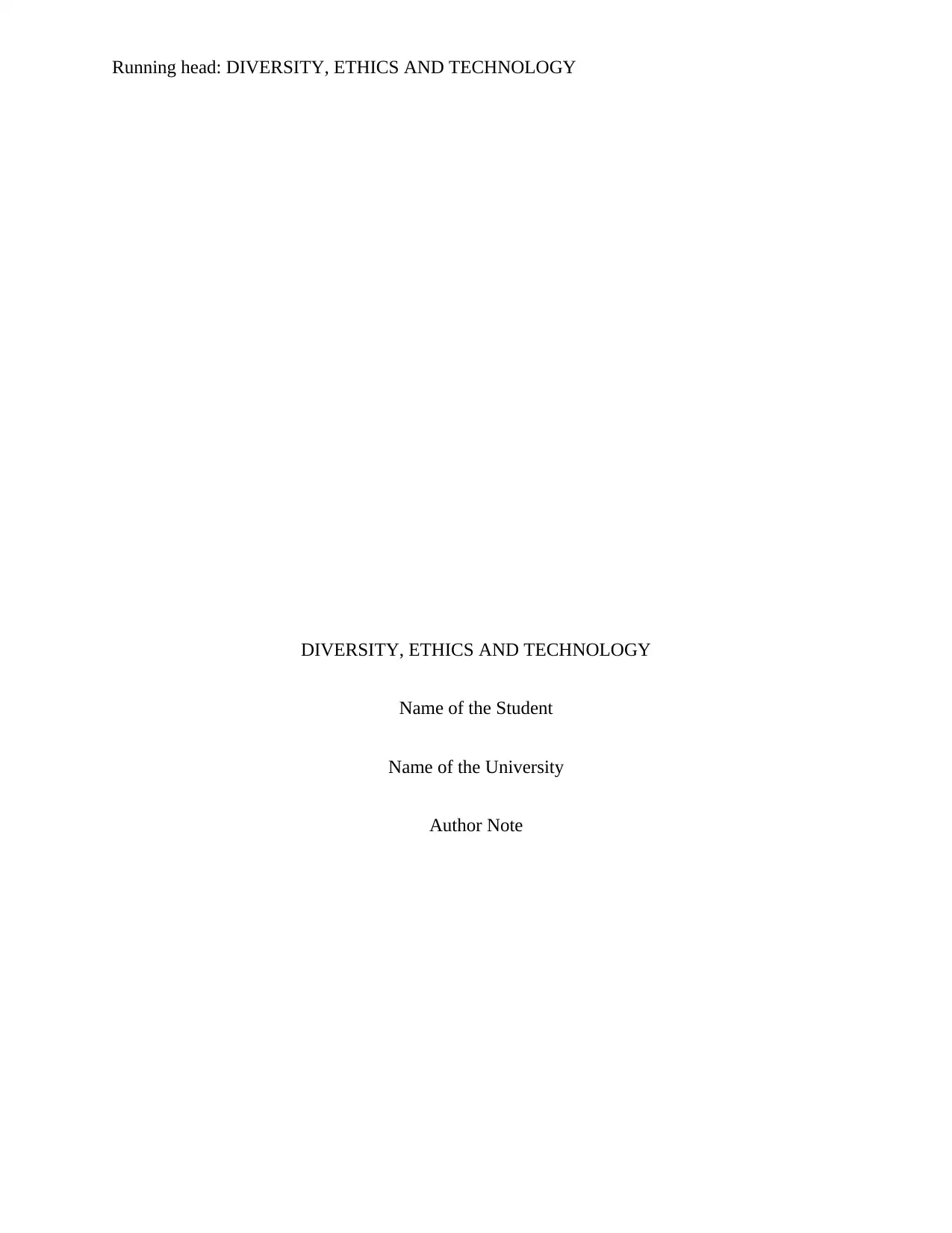
Running head: DIVERSITY, ETHICS AND TECHNOLOGY
DIVERSITY, ETHICS AND TECHNOLOGY
Name of the Student
Name of the University
Author Note
DIVERSITY, ETHICS AND TECHNOLOGY
Name of the Student
Name of the University
Author Note
Paraphrase This Document
Need a fresh take? Get an instant paraphrase of this document with our AI Paraphraser
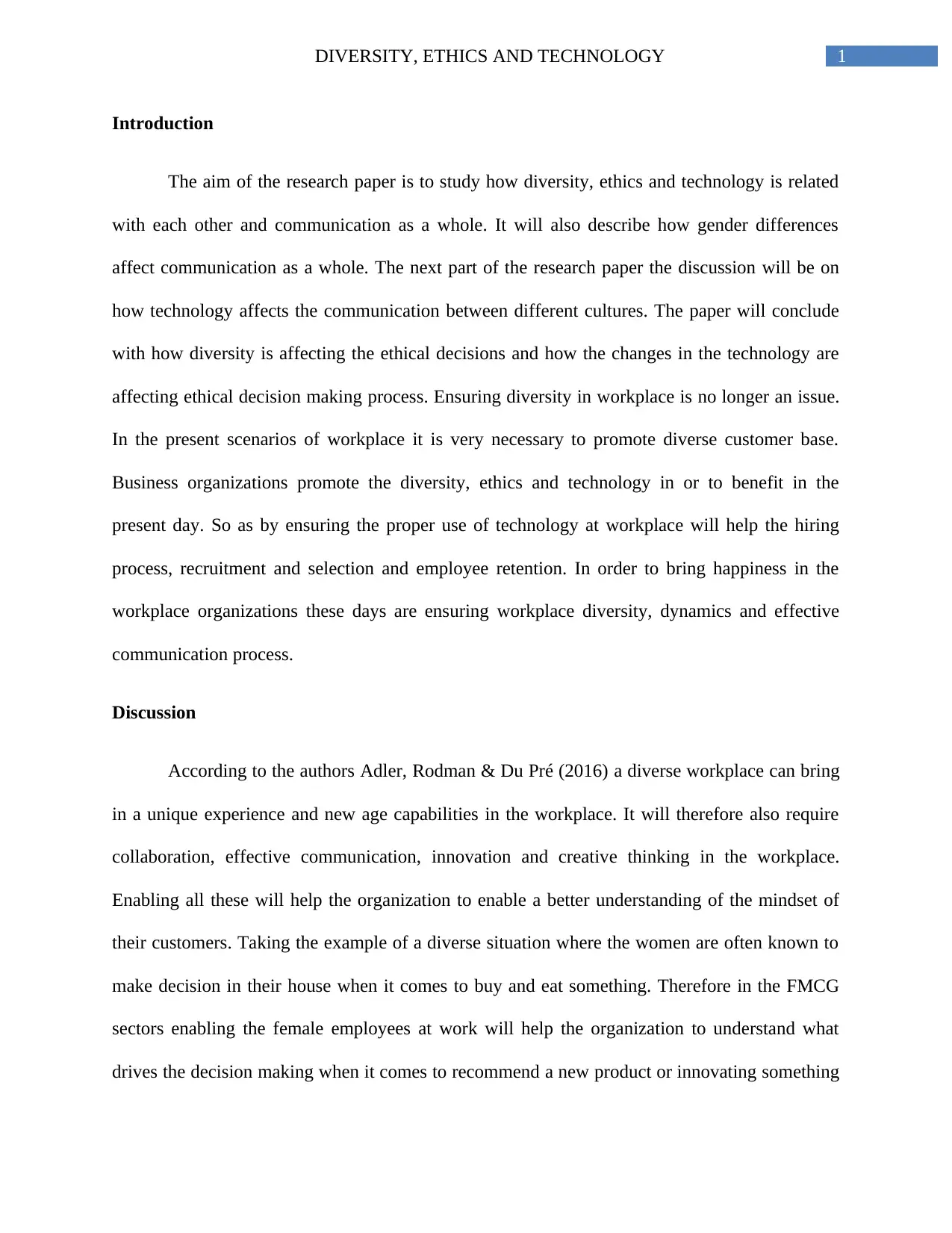
1DIVERSITY, ETHICS AND TECHNOLOGY
Introduction
The aim of the research paper is to study how diversity, ethics and technology is related
with each other and communication as a whole. It will also describe how gender differences
affect communication as a whole. The next part of the research paper the discussion will be on
how technology affects the communication between different cultures. The paper will conclude
with how diversity is affecting the ethical decisions and how the changes in the technology are
affecting ethical decision making process. Ensuring diversity in workplace is no longer an issue.
In the present scenarios of workplace it is very necessary to promote diverse customer base.
Business organizations promote the diversity, ethics and technology in or to benefit in the
present day. So as by ensuring the proper use of technology at workplace will help the hiring
process, recruitment and selection and employee retention. In order to bring happiness in the
workplace organizations these days are ensuring workplace diversity, dynamics and effective
communication process.
Discussion
According to the authors Adler, Rodman & Du Pré (2016) a diverse workplace can bring
in a unique experience and new age capabilities in the workplace. It will therefore also require
collaboration, effective communication, innovation and creative thinking in the workplace.
Enabling all these will help the organization to enable a better understanding of the mindset of
their customers. Taking the example of a diverse situation where the women are often known to
make decision in their house when it comes to buy and eat something. Therefore in the FMCG
sectors enabling the female employees at work will help the organization to understand what
drives the decision making when it comes to recommend a new product or innovating something
Introduction
The aim of the research paper is to study how diversity, ethics and technology is related
with each other and communication as a whole. It will also describe how gender differences
affect communication as a whole. The next part of the research paper the discussion will be on
how technology affects the communication between different cultures. The paper will conclude
with how diversity is affecting the ethical decisions and how the changes in the technology are
affecting ethical decision making process. Ensuring diversity in workplace is no longer an issue.
In the present scenarios of workplace it is very necessary to promote diverse customer base.
Business organizations promote the diversity, ethics and technology in or to benefit in the
present day. So as by ensuring the proper use of technology at workplace will help the hiring
process, recruitment and selection and employee retention. In order to bring happiness in the
workplace organizations these days are ensuring workplace diversity, dynamics and effective
communication process.
Discussion
According to the authors Adler, Rodman & Du Pré (2016) a diverse workplace can bring
in a unique experience and new age capabilities in the workplace. It will therefore also require
collaboration, effective communication, innovation and creative thinking in the workplace.
Enabling all these will help the organization to enable a better understanding of the mindset of
their customers. Taking the example of a diverse situation where the women are often known to
make decision in their house when it comes to buy and eat something. Therefore in the FMCG
sectors enabling the female employees at work will help the organization to understand what
drives the decision making when it comes to recommend a new product or innovating something
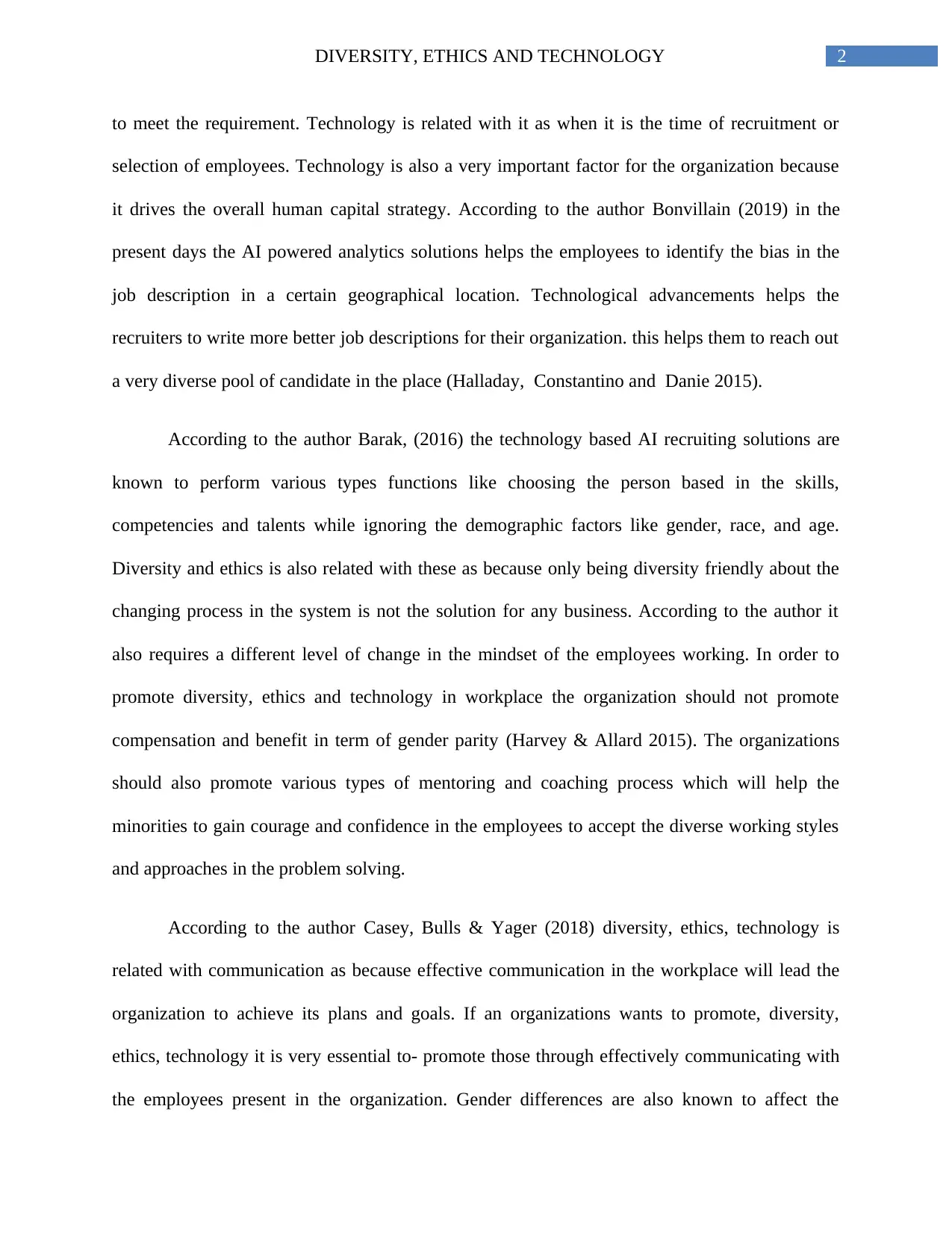
2DIVERSITY, ETHICS AND TECHNOLOGY
to meet the requirement. Technology is related with it as when it is the time of recruitment or
selection of employees. Technology is also a very important factor for the organization because
it drives the overall human capital strategy. According to the author Bonvillain (2019) in the
present days the AI powered analytics solutions helps the employees to identify the bias in the
job description in a certain geographical location. Technological advancements helps the
recruiters to write more better job descriptions for their organization. this helps them to reach out
a very diverse pool of candidate in the place (Halladay, Constantino and Danie 2015).
According to the author Barak, (2016) the technology based AI recruiting solutions are
known to perform various types functions like choosing the person based in the skills,
competencies and talents while ignoring the demographic factors like gender, race, and age.
Diversity and ethics is also related with these as because only being diversity friendly about the
changing process in the system is not the solution for any business. According to the author it
also requires a different level of change in the mindset of the employees working. In order to
promote diversity, ethics and technology in workplace the organization should not promote
compensation and benefit in term of gender parity (Harvey & Allard 2015). The organizations
should also promote various types of mentoring and coaching process which will help the
minorities to gain courage and confidence in the employees to accept the diverse working styles
and approaches in the problem solving.
According to the author Casey, Bulls & Yager (2018) diversity, ethics, technology is
related with communication as because effective communication in the workplace will lead the
organization to achieve its plans and goals. If an organizations wants to promote, diversity,
ethics, technology it is very essential to- promote those through effectively communicating with
the employees present in the organization. Gender differences are also known to affect the
to meet the requirement. Technology is related with it as when it is the time of recruitment or
selection of employees. Technology is also a very important factor for the organization because
it drives the overall human capital strategy. According to the author Bonvillain (2019) in the
present days the AI powered analytics solutions helps the employees to identify the bias in the
job description in a certain geographical location. Technological advancements helps the
recruiters to write more better job descriptions for their organization. this helps them to reach out
a very diverse pool of candidate in the place (Halladay, Constantino and Danie 2015).
According to the author Barak, (2016) the technology based AI recruiting solutions are
known to perform various types functions like choosing the person based in the skills,
competencies and talents while ignoring the demographic factors like gender, race, and age.
Diversity and ethics is also related with these as because only being diversity friendly about the
changing process in the system is not the solution for any business. According to the author it
also requires a different level of change in the mindset of the employees working. In order to
promote diversity, ethics and technology in workplace the organization should not promote
compensation and benefit in term of gender parity (Harvey & Allard 2015). The organizations
should also promote various types of mentoring and coaching process which will help the
minorities to gain courage and confidence in the employees to accept the diverse working styles
and approaches in the problem solving.
According to the author Casey, Bulls & Yager (2018) diversity, ethics, technology is
related with communication as because effective communication in the workplace will lead the
organization to achieve its plans and goals. If an organizations wants to promote, diversity,
ethics, technology it is very essential to- promote those through effectively communicating with
the employees present in the organization. Gender differences are also known to affect the
⊘ This is a preview!⊘
Do you want full access?
Subscribe today to unlock all pages.

Trusted by 1+ million students worldwide
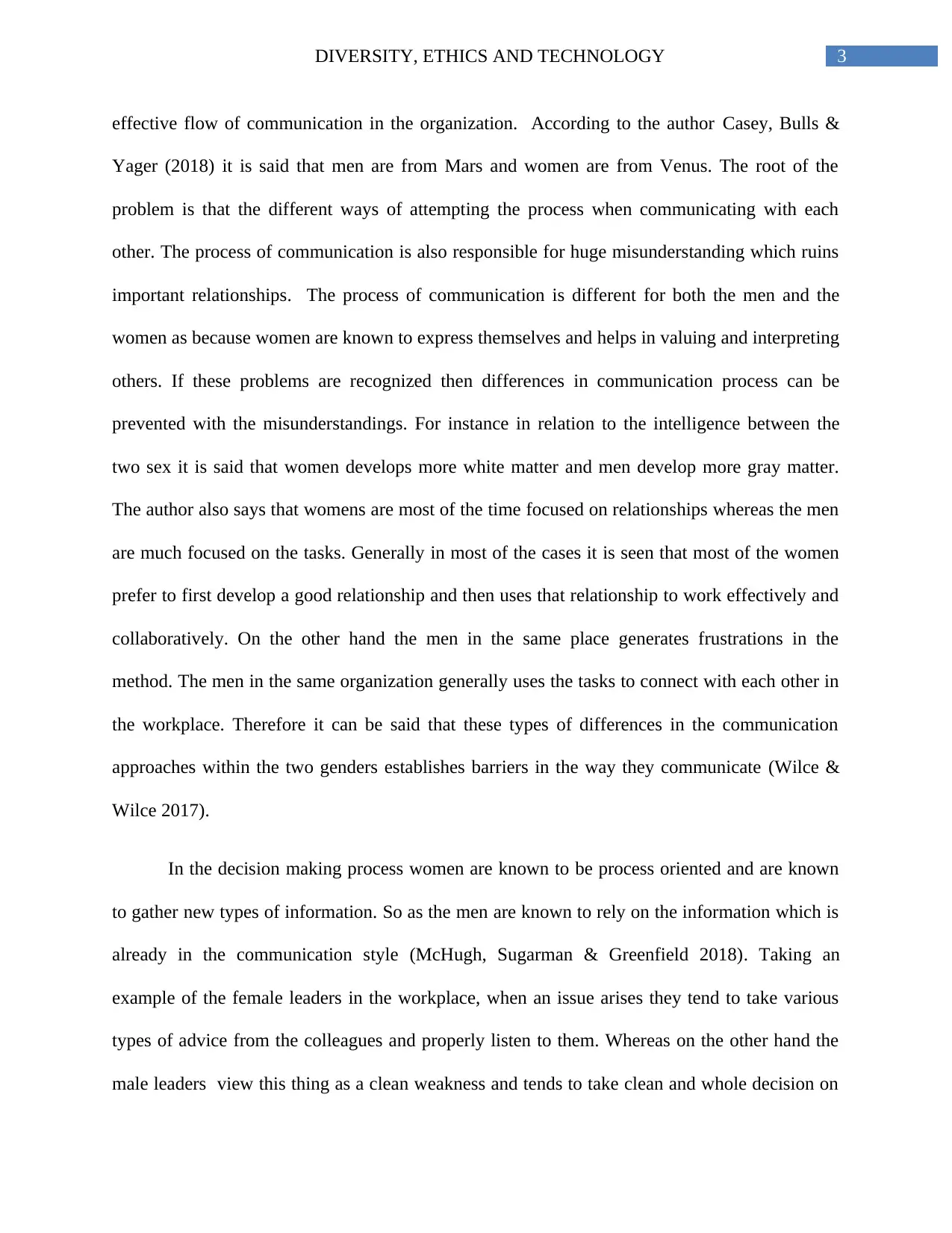
3DIVERSITY, ETHICS AND TECHNOLOGY
effective flow of communication in the organization. According to the author Casey, Bulls &
Yager (2018) it is said that men are from Mars and women are from Venus. The root of the
problem is that the different ways of attempting the process when communicating with each
other. The process of communication is also responsible for huge misunderstanding which ruins
important relationships. The process of communication is different for both the men and the
women as because women are known to express themselves and helps in valuing and interpreting
others. If these problems are recognized then differences in communication process can be
prevented with the misunderstandings. For instance in relation to the intelligence between the
two sex it is said that women develops more white matter and men develop more gray matter.
The author also says that womens are most of the time focused on relationships whereas the men
are much focused on the tasks. Generally in most of the cases it is seen that most of the women
prefer to first develop a good relationship and then uses that relationship to work effectively and
collaboratively. On the other hand the men in the same place generates frustrations in the
method. The men in the same organization generally uses the tasks to connect with each other in
the workplace. Therefore it can be said that these types of differences in the communication
approaches within the two genders establishes barriers in the way they communicate (Wilce &
Wilce 2017).
In the decision making process women are known to be process oriented and are known
to gather new types of information. So as the men are known to rely on the information which is
already in the communication style (McHugh, Sugarman & Greenfield 2018). Taking an
example of the female leaders in the workplace, when an issue arises they tend to take various
types of advice from the colleagues and properly listen to them. Whereas on the other hand the
male leaders view this thing as a clean weakness and tends to take clean and whole decision on
effective flow of communication in the organization. According to the author Casey, Bulls &
Yager (2018) it is said that men are from Mars and women are from Venus. The root of the
problem is that the different ways of attempting the process when communicating with each
other. The process of communication is also responsible for huge misunderstanding which ruins
important relationships. The process of communication is different for both the men and the
women as because women are known to express themselves and helps in valuing and interpreting
others. If these problems are recognized then differences in communication process can be
prevented with the misunderstandings. For instance in relation to the intelligence between the
two sex it is said that women develops more white matter and men develop more gray matter.
The author also says that womens are most of the time focused on relationships whereas the men
are much focused on the tasks. Generally in most of the cases it is seen that most of the women
prefer to first develop a good relationship and then uses that relationship to work effectively and
collaboratively. On the other hand the men in the same place generates frustrations in the
method. The men in the same organization generally uses the tasks to connect with each other in
the workplace. Therefore it can be said that these types of differences in the communication
approaches within the two genders establishes barriers in the way they communicate (Wilce &
Wilce 2017).
In the decision making process women are known to be process oriented and are known
to gather new types of information. So as the men are known to rely on the information which is
already in the communication style (McHugh, Sugarman & Greenfield 2018). Taking an
example of the female leaders in the workplace, when an issue arises they tend to take various
types of advice from the colleagues and properly listen to them. Whereas on the other hand the
male leaders view this thing as a clean weakness and tends to take clean and whole decision on
Paraphrase This Document
Need a fresh take? Get an instant paraphrase of this document with our AI Paraphraser
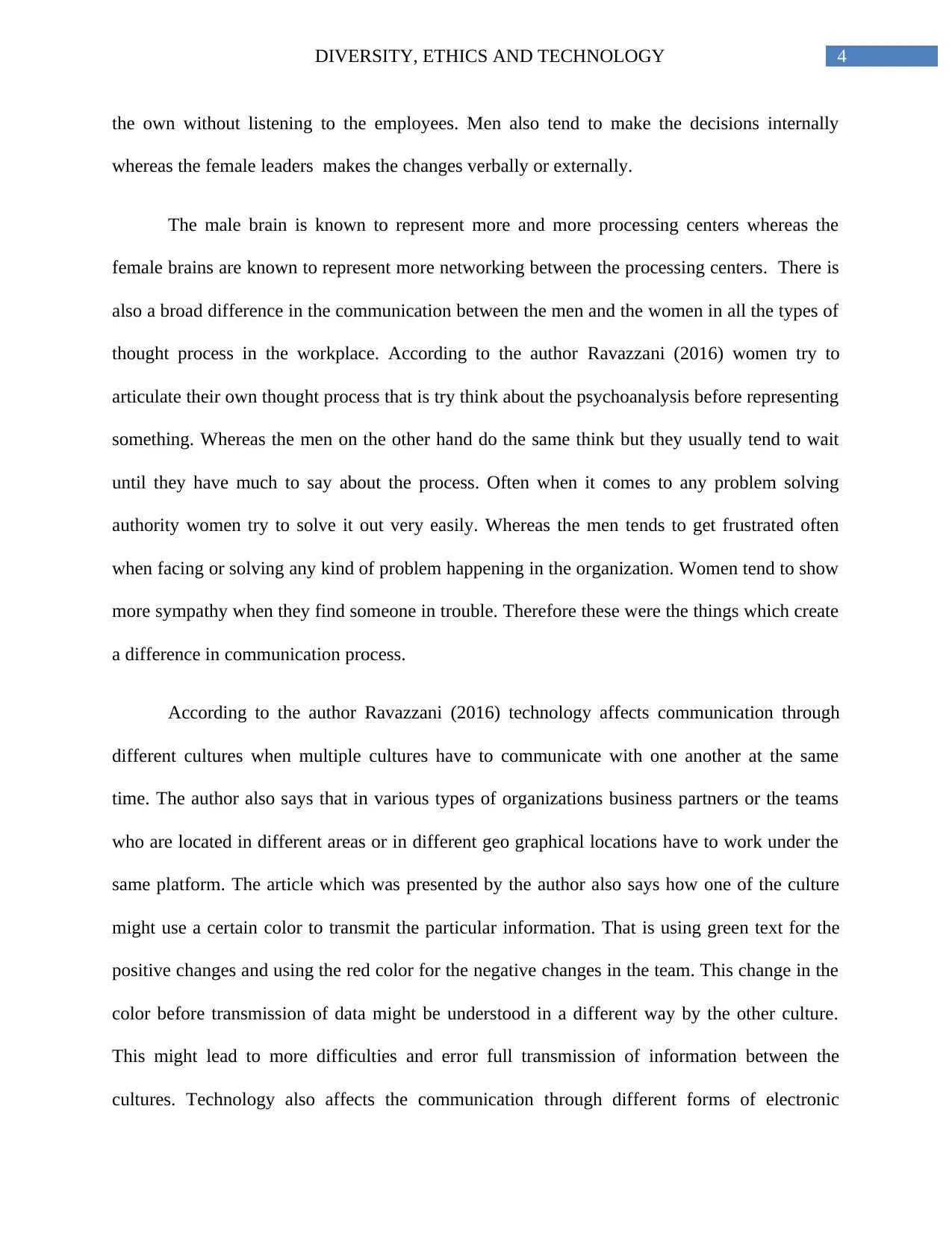
4DIVERSITY, ETHICS AND TECHNOLOGY
the own without listening to the employees. Men also tend to make the decisions internally
whereas the female leaders makes the changes verbally or externally.
The male brain is known to represent more and more processing centers whereas the
female brains are known to represent more networking between the processing centers. There is
also a broad difference in the communication between the men and the women in all the types of
thought process in the workplace. According to the author Ravazzani (2016) women try to
articulate their own thought process that is try think about the psychoanalysis before representing
something. Whereas the men on the other hand do the same think but they usually tend to wait
until they have much to say about the process. Often when it comes to any problem solving
authority women try to solve it out very easily. Whereas the men tends to get frustrated often
when facing or solving any kind of problem happening in the organization. Women tend to show
more sympathy when they find someone in trouble. Therefore these were the things which create
a difference in communication process.
According to the author Ravazzani (2016) technology affects communication through
different cultures when multiple cultures have to communicate with one another at the same
time. The author also says that in various types of organizations business partners or the teams
who are located in different areas or in different geo graphical locations have to work under the
same platform. The article which was presented by the author also says how one of the culture
might use a certain color to transmit the particular information. That is using green text for the
positive changes and using the red color for the negative changes in the team. This change in the
color before transmission of data might be understood in a different way by the other culture.
This might lead to more difficulties and error full transmission of information between the
cultures. Technology also affects the communication through different forms of electronic
the own without listening to the employees. Men also tend to make the decisions internally
whereas the female leaders makes the changes verbally or externally.
The male brain is known to represent more and more processing centers whereas the
female brains are known to represent more networking between the processing centers. There is
also a broad difference in the communication between the men and the women in all the types of
thought process in the workplace. According to the author Ravazzani (2016) women try to
articulate their own thought process that is try think about the psychoanalysis before representing
something. Whereas the men on the other hand do the same think but they usually tend to wait
until they have much to say about the process. Often when it comes to any problem solving
authority women try to solve it out very easily. Whereas the men tends to get frustrated often
when facing or solving any kind of problem happening in the organization. Women tend to show
more sympathy when they find someone in trouble. Therefore these were the things which create
a difference in communication process.
According to the author Ravazzani (2016) technology affects communication through
different cultures when multiple cultures have to communicate with one another at the same
time. The author also says that in various types of organizations business partners or the teams
who are located in different areas or in different geo graphical locations have to work under the
same platform. The article which was presented by the author also says how one of the culture
might use a certain color to transmit the particular information. That is using green text for the
positive changes and using the red color for the negative changes in the team. This change in the
color before transmission of data might be understood in a different way by the other culture.
This might lead to more difficulties and error full transmission of information between the
cultures. Technology also affects the communication through different forms of electronic
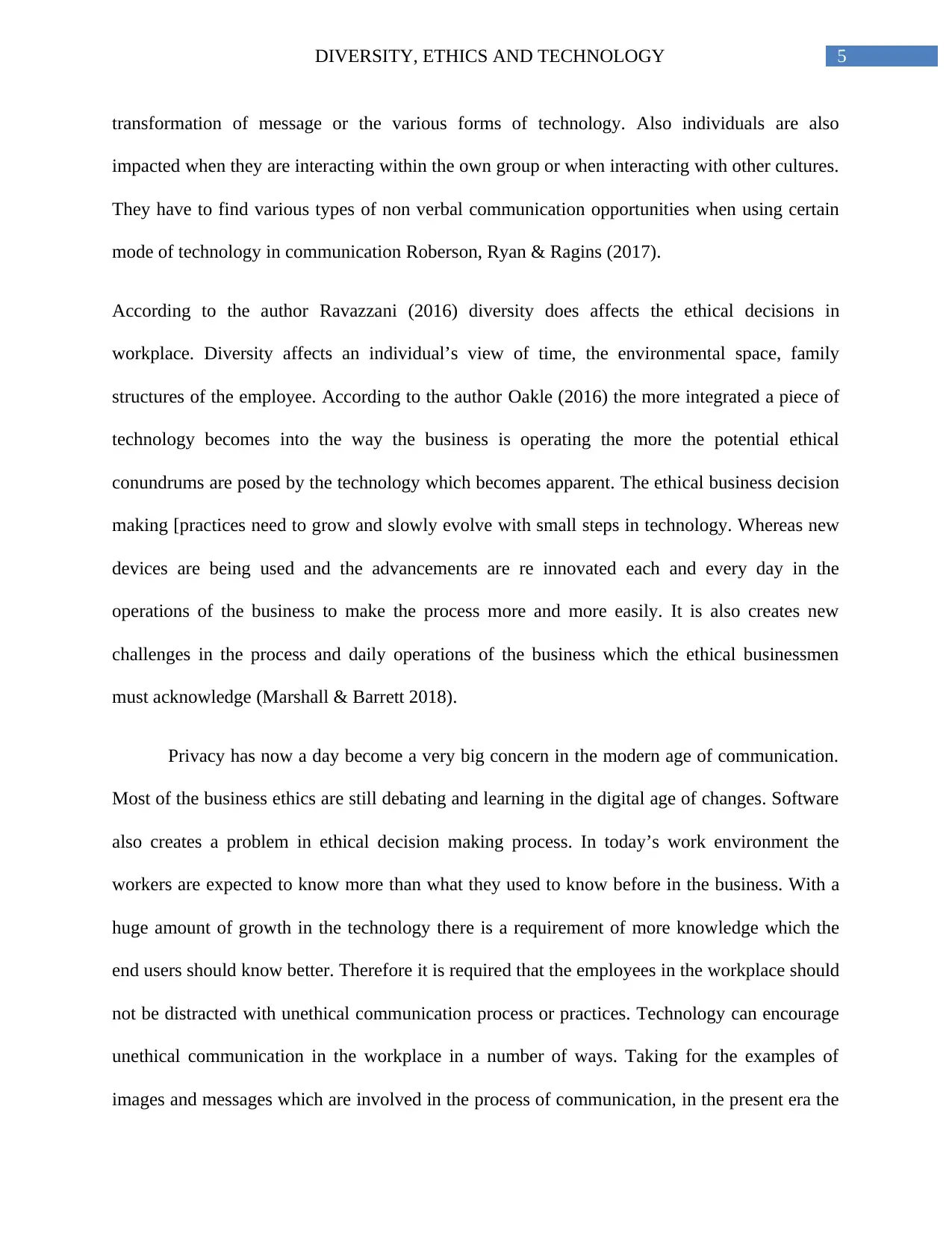
5DIVERSITY, ETHICS AND TECHNOLOGY
transformation of message or the various forms of technology. Also individuals are also
impacted when they are interacting within the own group or when interacting with other cultures.
They have to find various types of non verbal communication opportunities when using certain
mode of technology in communication Roberson, Ryan & Ragins (2017).
According to the author Ravazzani (2016) diversity does affects the ethical decisions in
workplace. Diversity affects an individual’s view of time, the environmental space, family
structures of the employee. According to the author Oakle (2016) the more integrated a piece of
technology becomes into the way the business is operating the more the potential ethical
conundrums are posed by the technology which becomes apparent. The ethical business decision
making [practices need to grow and slowly evolve with small steps in technology. Whereas new
devices are being used and the advancements are re innovated each and every day in the
operations of the business to make the process more and more easily. It is also creates new
challenges in the process and daily operations of the business which the ethical businessmen
must acknowledge (Marshall & Barrett 2018).
Privacy has now a day become a very big concern in the modern age of communication.
Most of the business ethics are still debating and learning in the digital age of changes. Software
also creates a problem in ethical decision making process. In today’s work environment the
workers are expected to know more than what they used to know before in the business. With a
huge amount of growth in the technology there is a requirement of more knowledge which the
end users should know better. Therefore it is required that the employees in the workplace should
not be distracted with unethical communication process or practices. Technology can encourage
unethical communication in the workplace in a number of ways. Taking for the examples of
images and messages which are involved in the process of communication, in the present era the
transformation of message or the various forms of technology. Also individuals are also
impacted when they are interacting within the own group or when interacting with other cultures.
They have to find various types of non verbal communication opportunities when using certain
mode of technology in communication Roberson, Ryan & Ragins (2017).
According to the author Ravazzani (2016) diversity does affects the ethical decisions in
workplace. Diversity affects an individual’s view of time, the environmental space, family
structures of the employee. According to the author Oakle (2016) the more integrated a piece of
technology becomes into the way the business is operating the more the potential ethical
conundrums are posed by the technology which becomes apparent. The ethical business decision
making [practices need to grow and slowly evolve with small steps in technology. Whereas new
devices are being used and the advancements are re innovated each and every day in the
operations of the business to make the process more and more easily. It is also creates new
challenges in the process and daily operations of the business which the ethical businessmen
must acknowledge (Marshall & Barrett 2018).
Privacy has now a day become a very big concern in the modern age of communication.
Most of the business ethics are still debating and learning in the digital age of changes. Software
also creates a problem in ethical decision making process. In today’s work environment the
workers are expected to know more than what they used to know before in the business. With a
huge amount of growth in the technology there is a requirement of more knowledge which the
end users should know better. Therefore it is required that the employees in the workplace should
not be distracted with unethical communication process or practices. Technology can encourage
unethical communication in the workplace in a number of ways. Taking for the examples of
images and messages which are involved in the process of communication, in the present era the
⊘ This is a preview!⊘
Do you want full access?
Subscribe today to unlock all pages.

Trusted by 1+ million students worldwide
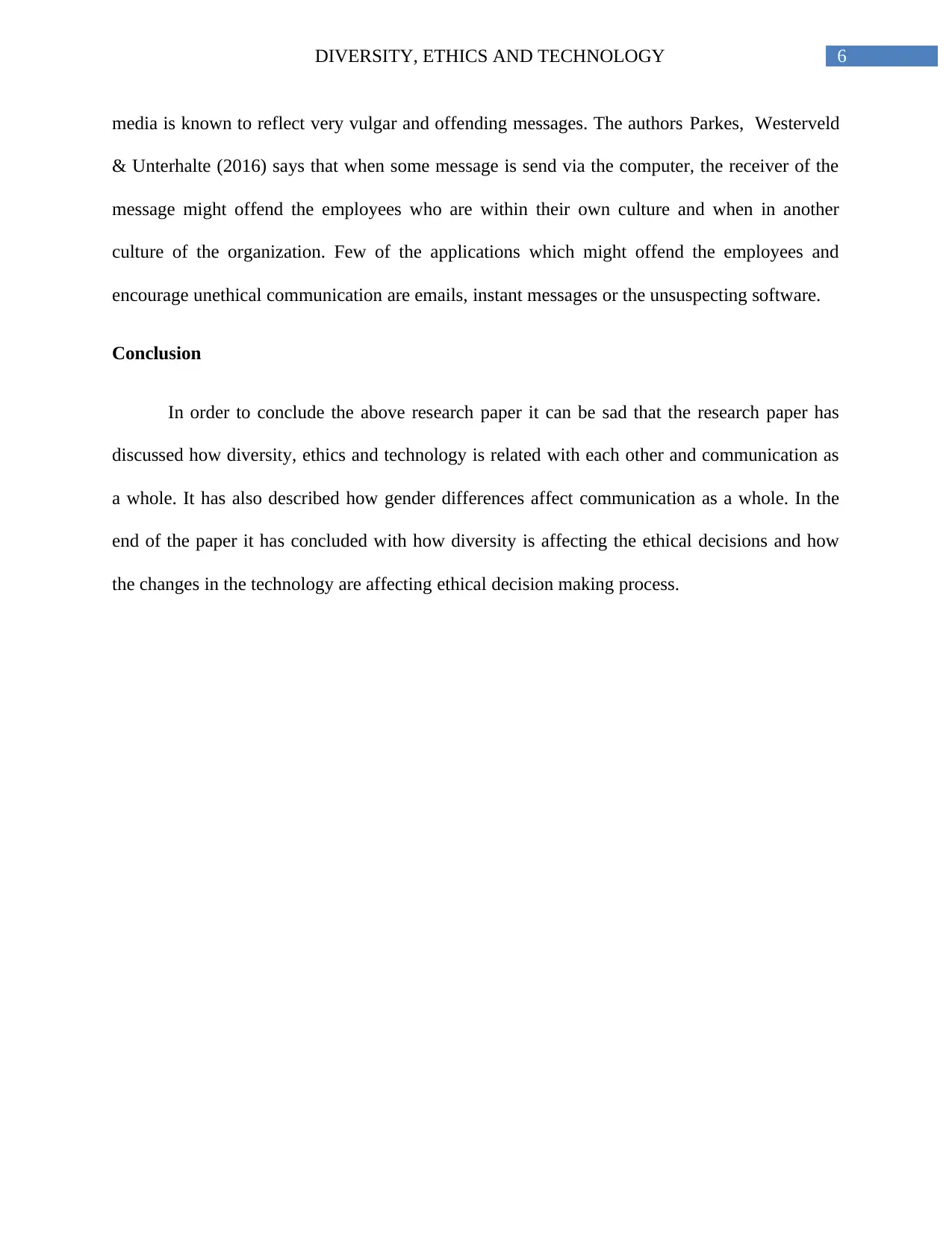
6DIVERSITY, ETHICS AND TECHNOLOGY
media is known to reflect very vulgar and offending messages. The authors Parkes, Westerveld
& Unterhalte (2016) says that when some message is send via the computer, the receiver of the
message might offend the employees who are within their own culture and when in another
culture of the organization. Few of the applications which might offend the employees and
encourage unethical communication are emails, instant messages or the unsuspecting software.
Conclusion
In order to conclude the above research paper it can be sad that the research paper has
discussed how diversity, ethics and technology is related with each other and communication as
a whole. It has also described how gender differences affect communication as a whole. In the
end of the paper it has concluded with how diversity is affecting the ethical decisions and how
the changes in the technology are affecting ethical decision making process.
media is known to reflect very vulgar and offending messages. The authors Parkes, Westerveld
& Unterhalte (2016) says that when some message is send via the computer, the receiver of the
message might offend the employees who are within their own culture and when in another
culture of the organization. Few of the applications which might offend the employees and
encourage unethical communication are emails, instant messages or the unsuspecting software.
Conclusion
In order to conclude the above research paper it can be sad that the research paper has
discussed how diversity, ethics and technology is related with each other and communication as
a whole. It has also described how gender differences affect communication as a whole. In the
end of the paper it has concluded with how diversity is affecting the ethical decisions and how
the changes in the technology are affecting ethical decision making process.
Paraphrase This Document
Need a fresh take? Get an instant paraphrase of this document with our AI Paraphraser
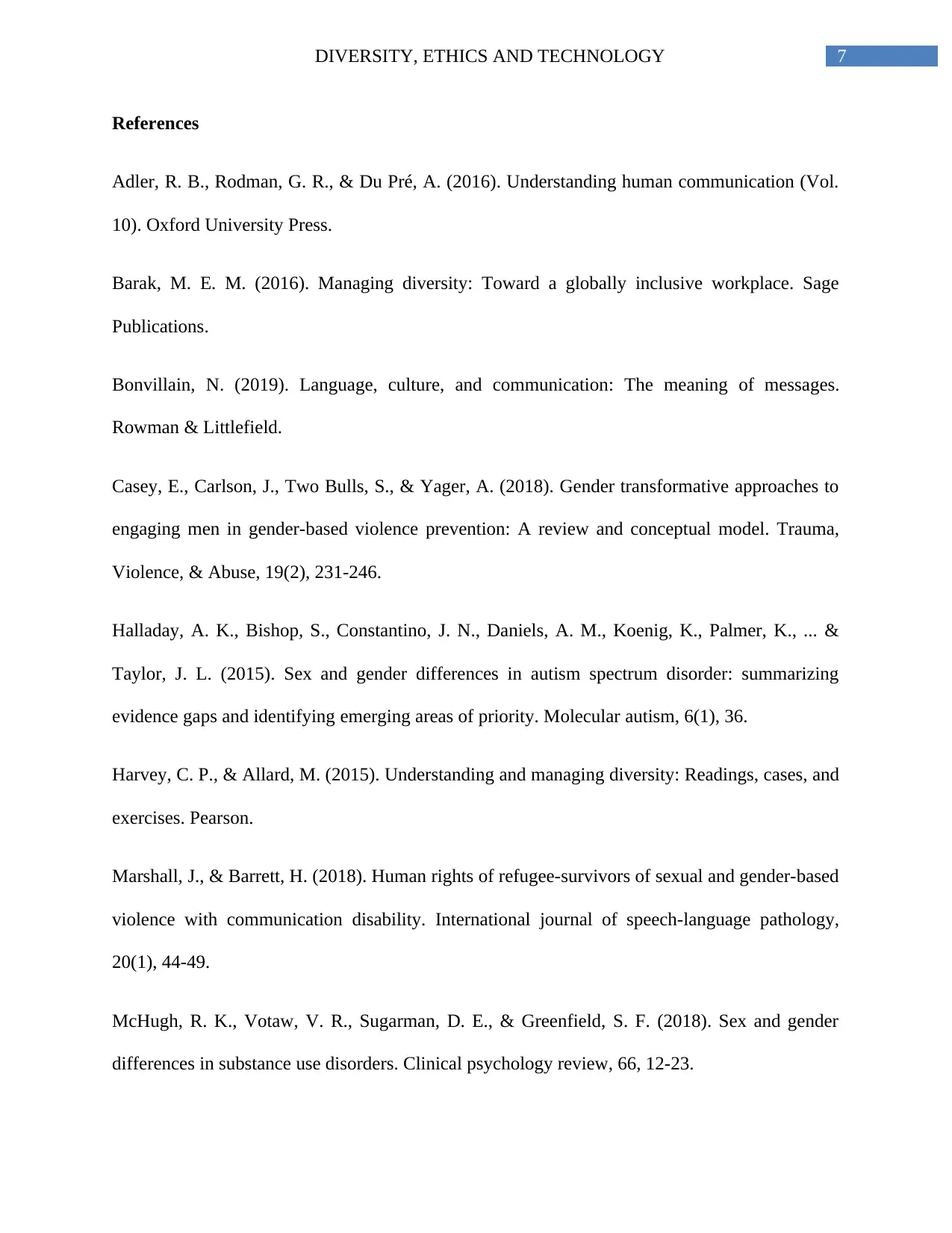
7DIVERSITY, ETHICS AND TECHNOLOGY
References
Adler, R. B., Rodman, G. R., & Du Pré, A. (2016). Understanding human communication (Vol.
10). Oxford University Press.
Barak, M. E. M. (2016). Managing diversity: Toward a globally inclusive workplace. Sage
Publications.
Bonvillain, N. (2019). Language, culture, and communication: The meaning of messages.
Rowman & Littlefield.
Casey, E., Carlson, J., Two Bulls, S., & Yager, A. (2018). Gender transformative approaches to
engaging men in gender-based violence prevention: A review and conceptual model. Trauma,
Violence, & Abuse, 19(2), 231-246.
Halladay, A. K., Bishop, S., Constantino, J. N., Daniels, A. M., Koenig, K., Palmer, K., ... &
Taylor, J. L. (2015). Sex and gender differences in autism spectrum disorder: summarizing
evidence gaps and identifying emerging areas of priority. Molecular autism, 6(1), 36.
Harvey, C. P., & Allard, M. (2015). Understanding and managing diversity: Readings, cases, and
exercises. Pearson.
Marshall, J., & Barrett, H. (2018). Human rights of refugee-survivors of sexual and gender-based
violence with communication disability. International journal of speech-language pathology,
20(1), 44-49.
McHugh, R. K., Votaw, V. R., Sugarman, D. E., & Greenfield, S. F. (2018). Sex and gender
differences in substance use disorders. Clinical psychology review, 66, 12-23.
References
Adler, R. B., Rodman, G. R., & Du Pré, A. (2016). Understanding human communication (Vol.
10). Oxford University Press.
Barak, M. E. M. (2016). Managing diversity: Toward a globally inclusive workplace. Sage
Publications.
Bonvillain, N. (2019). Language, culture, and communication: The meaning of messages.
Rowman & Littlefield.
Casey, E., Carlson, J., Two Bulls, S., & Yager, A. (2018). Gender transformative approaches to
engaging men in gender-based violence prevention: A review and conceptual model. Trauma,
Violence, & Abuse, 19(2), 231-246.
Halladay, A. K., Bishop, S., Constantino, J. N., Daniels, A. M., Koenig, K., Palmer, K., ... &
Taylor, J. L. (2015). Sex and gender differences in autism spectrum disorder: summarizing
evidence gaps and identifying emerging areas of priority. Molecular autism, 6(1), 36.
Harvey, C. P., & Allard, M. (2015). Understanding and managing diversity: Readings, cases, and
exercises. Pearson.
Marshall, J., & Barrett, H. (2018). Human rights of refugee-survivors of sexual and gender-based
violence with communication disability. International journal of speech-language pathology,
20(1), 44-49.
McHugh, R. K., Votaw, V. R., Sugarman, D. E., & Greenfield, S. F. (2018). Sex and gender
differences in substance use disorders. Clinical psychology review, 66, 12-23.
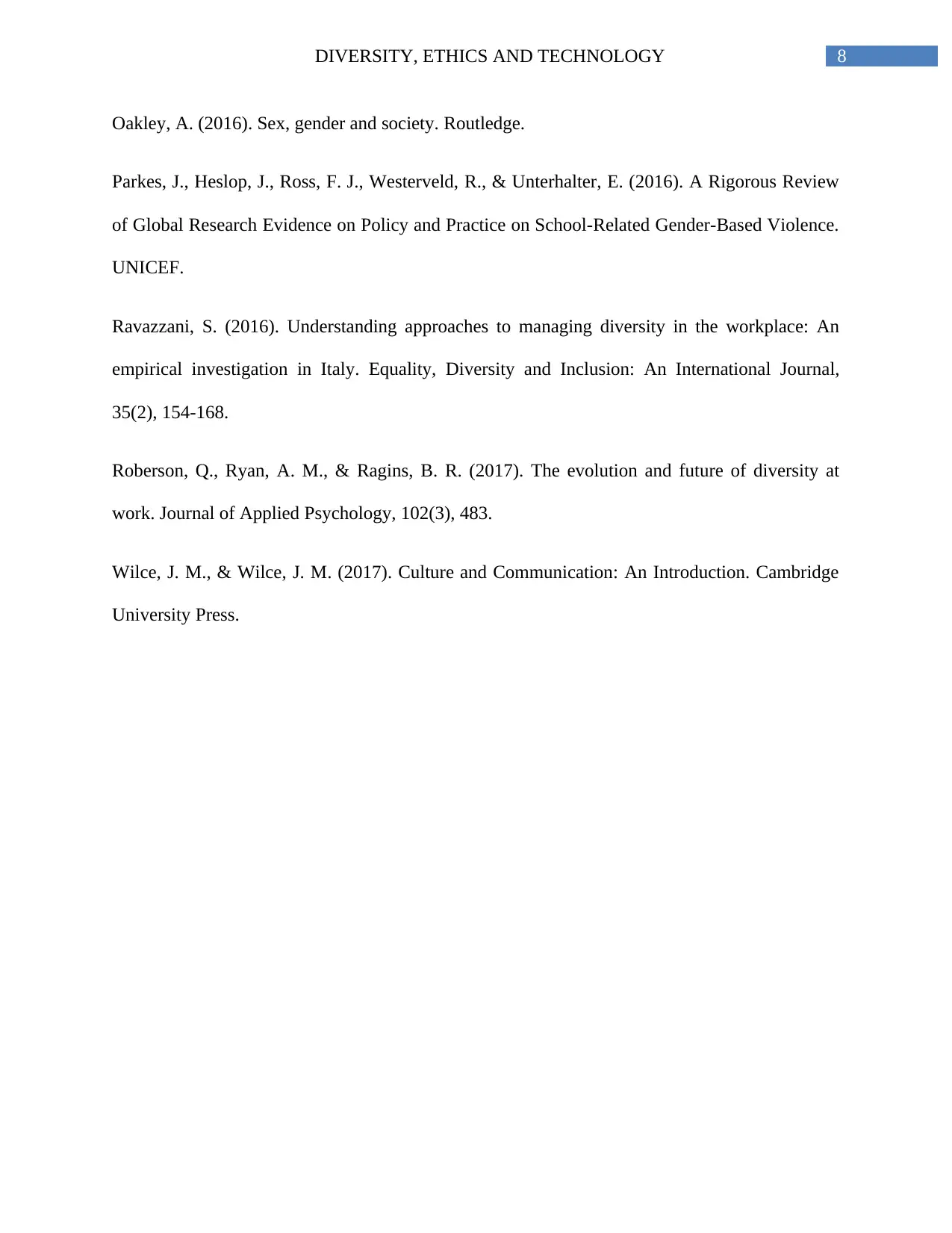
8DIVERSITY, ETHICS AND TECHNOLOGY
Oakley, A. (2016). Sex, gender and society. Routledge.
Parkes, J., Heslop, J., Ross, F. J., Westerveld, R., & Unterhalter, E. (2016). A Rigorous Review
of Global Research Evidence on Policy and Practice on School-Related Gender-Based Violence.
UNICEF.
Ravazzani, S. (2016). Understanding approaches to managing diversity in the workplace: An
empirical investigation in Italy. Equality, Diversity and Inclusion: An International Journal,
35(2), 154-168.
Roberson, Q., Ryan, A. M., & Ragins, B. R. (2017). The evolution and future of diversity at
work. Journal of Applied Psychology, 102(3), 483.
Wilce, J. M., & Wilce, J. M. (2017). Culture and Communication: An Introduction. Cambridge
University Press.
Oakley, A. (2016). Sex, gender and society. Routledge.
Parkes, J., Heslop, J., Ross, F. J., Westerveld, R., & Unterhalter, E. (2016). A Rigorous Review
of Global Research Evidence on Policy and Practice on School-Related Gender-Based Violence.
UNICEF.
Ravazzani, S. (2016). Understanding approaches to managing diversity in the workplace: An
empirical investigation in Italy. Equality, Diversity and Inclusion: An International Journal,
35(2), 154-168.
Roberson, Q., Ryan, A. M., & Ragins, B. R. (2017). The evolution and future of diversity at
work. Journal of Applied Psychology, 102(3), 483.
Wilce, J. M., & Wilce, J. M. (2017). Culture and Communication: An Introduction. Cambridge
University Press.
⊘ This is a preview!⊘
Do you want full access?
Subscribe today to unlock all pages.

Trusted by 1+ million students worldwide
1 out of 9
Related Documents
Your All-in-One AI-Powered Toolkit for Academic Success.
+13062052269
info@desklib.com
Available 24*7 on WhatsApp / Email
![[object Object]](/_next/static/media/star-bottom.7253800d.svg)
Unlock your academic potential
Copyright © 2020–2025 A2Z Services. All Rights Reserved. Developed and managed by ZUCOL.





